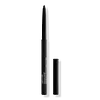What's inside
What's inside
 Key Ingredients
Key Ingredients

 Benefits
Benefits

 Concerns
Concerns

 Ingredients Side-by-side
Ingredients Side-by-side

Synthetic Wax
AbrasiveIsododecane
EmollientTrimethylsiloxysilicate
EmollientPhenylpropyldimethylsiloxysilicate
EmollientMicrocrystalline Wax
Emulsion StabilisingIsobutylmethacrylate/Bis-Hydroxypropyl Dimethicone Acrylate Copolymer
Polyisoprene
Methyl Methacrylate Crosspolymer
Dimethicone
EmollientCaprylic/Capric Triglyceride
MaskingVp/Hexadecene Copolymer
Disteardimonium Hectorite
StabilisingPropylene Carbonate
SolventIron Oxides
CI 77492
Cosmetic ColorantCI 77499
Cosmetic ColorantCI 77266
Cosmetic ColorantUltramarines
CI 77510
Cosmetic ColorantTitanium Dioxide
Cosmetic ColorantSynthetic Wax, Isododecane, Trimethylsiloxysilicate, Phenylpropyldimethylsiloxysilicate, Microcrystalline Wax, Isobutylmethacrylate/Bis-Hydroxypropyl Dimethicone Acrylate Copolymer, Polyisoprene, Methyl Methacrylate Crosspolymer, Dimethicone, Caprylic/Capric Triglyceride, Vp/Hexadecene Copolymer, Disteardimonium Hectorite, Propylene Carbonate, Iron Oxides, CI 77492, CI 77499, CI 77266, Ultramarines, CI 77510, Titanium Dioxide
Isododecane
EmollientSynthetic Wax
AbrasiveTrimethylsiloxysilicate
EmollientDimethicone
EmollientPolybutene
Synthetic Fluorphlogopite
Polyglyceryl-4 Diisostearate/Polyhydroxystearate/Sebacate
EmulsifyingCaprylic/Capric Triglyceride
MaskingStearalkonium Hectorite
Gel FormingMagnesium Oxide
AbsorbentPropylene Carbonate
SolventAlumina
AbrasiveCI 77491
Cosmetic ColorantCI 77492
Cosmetic ColorantCI 77499
Cosmetic ColorantIngredients Explained
These ingredients are found in both products.
Ingredients higher up in an ingredient list are typically present in a larger amount.
This ingredient is an emollient, solvent, and texture enhancer. It is considered a skin-softener by helping the skin prevent moisture loss.
It helps thicken a product's formula and makes it easier to spread by dissolving clumping compounds.
Caprylic Triglyceride is made by combining glycerin with coconut oil, forming a clear liquid.
While there is an assumption Caprylic Triglyceride can clog pores due to it being derived from coconut oil, there is no research supporting this.
Learn more about Caprylic/Capric TriglycerideCi 77492 is also hydrated iron III oxide. It's sole purpose is to give a yellow hue to products.
Iron III oxides are classified as inorganic chemicals for coloring.
Synthetically created Ci 77492 is considered safer than those naturally found. This is because the synthetically created version may contain less impurities. Iron oxides are generally non-toxic and non-allergenic.
Learn more about CI 77492Ci 77499 is also hydrated iron III oxide. It is created from mixing red and black iron oxides. This helps give shades of darkness to a product.
Iron III oxides are classified as inorganic chemicals for coloring.
Dimethicone is a type of synthetic silicone created from natural materials such as quartz.
What it does:
Dimethicone comes in different viscosities:
Depending on the viscosity, dimethicone has different properties.
Ingredients lists don't always show which type is used, so we recommend reaching out to the brand if you have questions about the viscosity.
This ingredient is unlikely to cause irritation because it does not get absorbed into skin. However, people with silicone allergies should be careful about using this ingredient.
Note: Dimethicone may contribute to pilling. This is because it is not oil or water soluble, so pilling may occur when layered with products. When mixed with heavy oils in a formula, the outcome is also quite greasy.
Learn more about DimethiconeIsododecane is a fragrance, emollient, and solvent.
As an emollient, it helps your skin stay soft and hydrated. Emollients help trap moisture into your skin.
Isododecane's role as a solvent makes it a great texture enhancer. It spreads smoothly on skin and does not leave a sticky feeling behind. Isododecane also helps prevent color transfer in makeup products.
Isododecane is not absorbed into skin.
Learn more about IsododecaneThis ingredient is a solvent. It helps dissolve active ingredients and alter the texture of products.
Propylene Carbonate is commonly used in makeup and with clay, such as montmorillonite or bentonite.
Studies show this ingredient to be safe for cosmetics. When it is undiluted, it can cause skin irritation. (It is always diluted in skincare and makeup). This ingredient is water-soluble.
Propylene Carbonate is created from propylene glycol and carbonic acid.
Learn more about Propylene CarbonateSynthetic Wax is created from fossil fuels such as natural gas. It is used to enhance texture, adjust pH, and as an occlusive.
It may also be used as an abrasive ingredient to exfoliate the skin.
Synthetic Wax may not be fungal acne safe.
Learn more about Synthetic WaxThis silicone is an emollient. Emollients create a thin film on the skin to prevent moisture from escaping.
It is not soluble in water and helps increase water-resistance in products.
According to a manufacturer, it can blend seamlessly with silicone oils, such as Cyclopentasiloxane.
Learn more about Trimethylsiloxysilicate